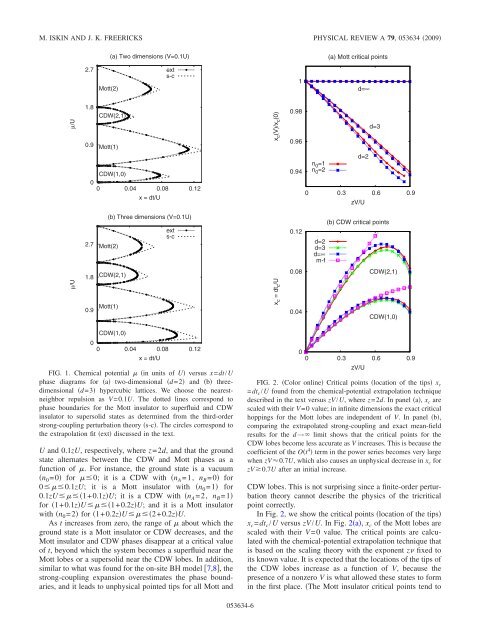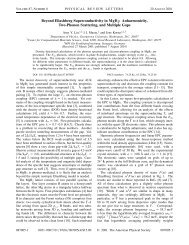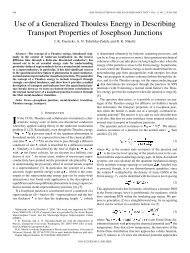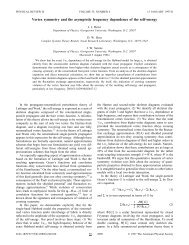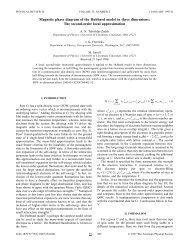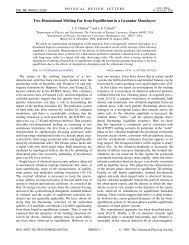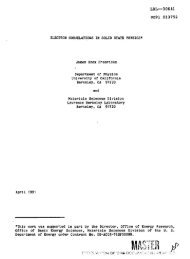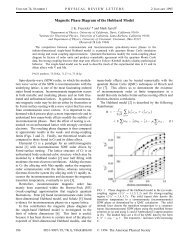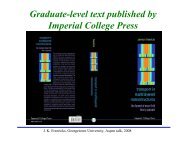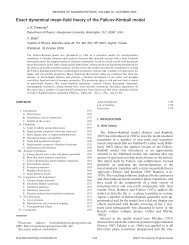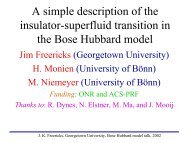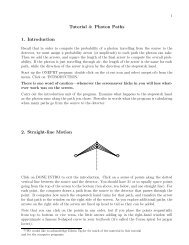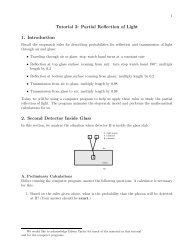Strong-coupling perturbation theory for the extended Bose-Hubbard ...
Strong-coupling perturbation theory for the extended Bose-Hubbard ...
Strong-coupling perturbation theory for the extended Bose-Hubbard ...
Create successful ePaper yourself
Turn your PDF publications into a flip-book with our unique Google optimized e-Paper software.
M. ISKIN AND J. K. FREERICKS PHYSICAL REVIEW A 79, 053634 2009<br />
(a) Two dimensions (V=0.1U)<br />
(a) Mott critical points<br />
2.7<br />
Mott(2)<br />
ext<br />
s-c<br />
1<br />
d=∞<br />
µ/U<br />
1.8<br />
CDW(2,1)<br />
0.9 Mott(1)<br />
x c (V)/x c (0)<br />
0.98<br />
0.96<br />
d=3<br />
CDW(1,0)<br />
0<br />
0 0.04 0.08 0.12<br />
x = dt/U<br />
0.94<br />
n 0 =1<br />
n 0 =2<br />
d=2<br />
0 0.3 0.6 0.9<br />
zV/U<br />
2.7<br />
(b) Three dimensions (V=0.1U)<br />
Mott(2)<br />
ext<br />
s-c<br />
0.12<br />
d=2<br />
d=3<br />
d=∞<br />
m-f<br />
(b) CDW critical points<br />
µ/U<br />
1.8<br />
0.9<br />
CDW(2,1)<br />
Mott(1)<br />
x c =dt c /U<br />
0.08<br />
0.04<br />
CDW(2,1)<br />
CDW(1,0)<br />
CDW(1,0)<br />
0<br />
0 0.04 0.08 0.12<br />
x=dt/U<br />
FIG. 1. Chemical potential in units of U versus x=dt/U<br />
phase diagrams <strong>for</strong> a two-dimensional d=2 and b threedimensional<br />
d=3 hypercubic lattices. We choose <strong>the</strong> nearestneighbor<br />
repulsion as V=0.1U. The dotted lines correspond to<br />
phase boundaries <strong>for</strong> <strong>the</strong> Mott insulator to superfluid and CDW<br />
insulator to supersolid states as determined from <strong>the</strong> third-order<br />
strong-<strong>coupling</strong> <strong>perturbation</strong> <strong><strong>the</strong>ory</strong> s-c. The circles correspond to<br />
<strong>the</strong> extrapolation fit ext discussed in <strong>the</strong> text.<br />
U and 0.1zU, respectively, where z=2d, and that <strong>the</strong> ground<br />
state alternates between <strong>the</strong> CDW and Mott phases as a<br />
function of . For instance, <strong>the</strong> ground state is a vacuum<br />
n 0 =0 <strong>for</strong> 0; it is a CDW with n A =1, n B =0 <strong>for</strong><br />
00.1zU; it is a Mott insulator with n 0 =1 <strong>for</strong><br />
0.1zU1+0.1zU; it is a CDW with n A =2, n B =1<br />
<strong>for</strong> 1+0.1zU1+0.2zU; and it is a Mott insulator<br />
with n 0 =2 <strong>for</strong> 1+0.2zU2+0.2zU.<br />
As t increases from zero, <strong>the</strong> range of about which <strong>the</strong><br />
ground state is a Mott insulator or CDW decreases, and <strong>the</strong><br />
Mott insulator and CDW phases disappear at a critical value<br />
of t, beyond which <strong>the</strong> system becomes a superfluid near <strong>the</strong><br />
Mott lobes or a supersolid near <strong>the</strong> CDW lobes. In addition,<br />
similar to what was found <strong>for</strong> <strong>the</strong> on-site BH model 7,8, <strong>the</strong><br />
strong-<strong>coupling</strong> expansion overestimates <strong>the</strong> phase boundaries,<br />
and it leads to unphysical pointed tips <strong>for</strong> all Mott and<br />
0<br />
0 0.3 0.6 0.9<br />
zV/U<br />
FIG. 2. Color online Critical points location of <strong>the</strong> tips x c<br />
=dt c /U found from <strong>the</strong> chemical-potential extrapolation technique<br />
described in <strong>the</strong> text versus zV/U, where z=2d. In panel a, x c are<br />
scaled with <strong>the</strong>ir V=0 value; in infinite dimensions <strong>the</strong> exact critical<br />
hoppings <strong>for</strong> <strong>the</strong> Mott lobes are independent of V. In panel b,<br />
comparing <strong>the</strong> extrapolated strong-<strong>coupling</strong> and exact mean-field<br />
results <strong>for</strong> <strong>the</strong> d→ limit shows that <strong>the</strong> critical points <strong>for</strong> <strong>the</strong><br />
CDW lobes become less accurate as V increases. This is because <strong>the</strong><br />
coefficient of <strong>the</strong> Ot 4 term in <strong>the</strong> power series becomes very large<br />
when zV0.7U, which also causes an unphysical decrease in x c <strong>for</strong><br />
zV0.7U after an initial increase.<br />
CDW lobes. This is not surprising since a finite-order <strong>perturbation</strong><br />
<strong><strong>the</strong>ory</strong> cannot describe <strong>the</strong> physics of <strong>the</strong> tricritical<br />
point correctly.<br />
In Fig. 2, we show <strong>the</strong> critical points location of <strong>the</strong> tips<br />
x c =dt c /U versus zV/U. In Fig. 2a, x c of <strong>the</strong> Mott lobes are<br />
scaled with <strong>the</strong>ir V=0 value. The critical points are calculated<br />
with <strong>the</strong> chemical-potential extrapolation technique that<br />
is based on <strong>the</strong> scaling <strong><strong>the</strong>ory</strong> with <strong>the</strong> exponent z fixed to<br />
its known value. It is expected that <strong>the</strong> locations of <strong>the</strong> tips of<br />
<strong>the</strong> CDW lobes increase as a function of V, because <strong>the</strong><br />
presence of a nonzero V is what allowed <strong>the</strong>se states to <strong>for</strong>m<br />
in <strong>the</strong> first place. The Mott insulator critical points tend to<br />
053634-6


